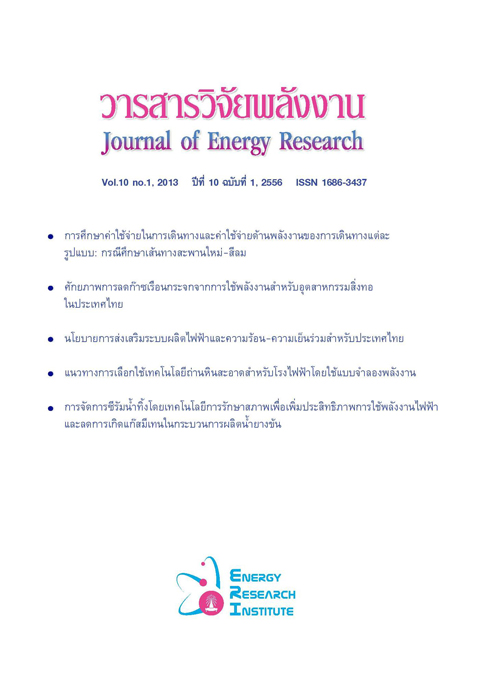การจัดการซีรัมน้ำทิ้งโดยเทคโนโลยีการรักษาสภาพเพื่อเพิ่มประสิทธิภาพการใช้พลังงานไฟฟ้าและลดการเกิด แก๊สมีเทนในกระบวนการผลิตน้ำยางข้น
Main Article Content
Abstract
ซีรัมน้ำทิ้งเป็นน้ำทิ้งที่เกิดจากกระบวนการสกิมของโรงงานผลิตน้ำยางข้น ซึ่งเป็นแหล่งน้ำทิ้งที่มีค่าบีโอดีมากที่สุด มีผลให้ต้องใช้พลังงานไฟฟ้าในการเติมอากาศเพื่อลดค่าบีโอดีของน้ำทิ้งรวมภายในโรงงานมากขึ้น ขณะเดียวกันซีรัมน้ำทิ้งดังกล่าวยังสามารถใช้เป็นแหล่งธาตุอาหารสำหรับพืชได้ แต่ยังคงมีข้อจำกัดในการใช้ประโยชน์เนื่องจากเสียสภาพได้ในเวลาอันสั้นจากการย่อยสลายสารอินทรีย์ในซีรัมน้ำทิ้งเหล่านั้น ดังนั้นเทคโนโลยีการรักษาสภาพซีรัมน้ำทิ้งด้วย สารกันบูดจึงเป็นประเด็นที่น่าสนใจ ซึ่งนำไปสู่การลดการใช้พลังงานไฟฟ้าและการเกิดแก๊สเรือนกระจกในกระบวน การผลิตน้ำยางข้นได้เป็นอย่างดี จึงวางแผนการทดลองแบบ Randomized Complete Block Design (RCBD) ทำ 3 ซ้ำ มี 10 ตำรับทดลอง ประกอบด้วยซีรัมน้ำทิ้งที่เติมสารกันบูด 3 ชนิด ชนิดละ 3 ระดับความเข้มข้น และซีรัมน้ำทิ้งที่ไม่เติมสิ่งทดลอง โดยหนึ่งหน่วยการทดลอง คือ ขวดพลาสติกประเภท High Density Polyethylene (HDPE) ขนาด 1000 ซีซี อีกทั้งทำการตรวจวัดปริมาณแก๊สมีเทนจากซีรัมน้ำทิ้งโดยใช้เทคนิค Fourier Transform Infrared (FT-IR)
ผลการศึกษา พบว่า สารกันบูดที่รักษาสภาพซีรัมน้ำทิ้งได้ดีที่สุด คือ โพแทสเซียมซอร์เบทที่ระดับความเข้มข้น 0.20% สามารถรักษาสภาพซีรัมน้ำทิ้งได้ยาวนานถึง 30 วัน โดยที่ยังคงรักษาปริมาณธาตุอาหารหลัก (N, P, K) ของพืชภายในซีรัมน้ำทิ้งไว้ได้ และมีผลให้ปริมาณโพแทสเซียมในซีรัมน้ำทิ้งเพิ่มขึ้นอย่างมีนัยสำคัญทางสถิติ ( p < 0.05) อีกทั้งสมบัติทางเคมีของซีรัมน้ำทิ้งภายหลังการรักษาสภาพ (pH =7.50) อยู่ในช่วงที่ไม่ก่อให้เกิดปัญหาต่อการเจริญเติบโตของพืช สำหรับค่าการนำไฟฟ้าพบว่าไม่แตกต่างทางสถิติกับซีรัมน้ำทิ้งที่ไม่ได้เติมสารกันบูด ทั้งนี้หากมีการบริหารจัดการโดยแยกซีรัมน้ำทิ้งออกจากระบบบำบัดน้ำทิ้งของโรงงาน ส่งผลให้การใช้พลังงานไฟฟ้าในการบำบัดน้ำทิ้งลดลง 24.78 – 42.37 กิโลวัตต์-ชั่วโมงต่อลูกบาศก์เมตร และลดการเกิดแก๊สมีเทนขณะที่มีกระบวนการสกิมได้ถึง 4.76 มิลลิกรัมต่อลิตร
Management of Serum Waste by Preservation Technology for Increasing Electric Energy Efficiency and Reducing Methane in the Concentrated Latex Process
Jenjira Phuriragpitikhon1 and Orawan Siriratpiriya2
1Energy Technology and Management Program, Graduate School, Chulalongkorn University
2Environmental Research Institute, Graduate School, Chulalongkorn University
Serum waste is the wastewater separated from skim process in the concentrated latex process. Because of high BOD within the serum the wastewater treatment system need more electricity consumption for aeration lead to reduction of BOD level. In the meantime, serum waste can be utilized as the nutrient sources for plant but its utilization has major limitation because of rapid deterioration. Therefore preservation technology by preservative materials for prolongs storage has high potential to maximize utility of the serum besides, reduction not only electricity consumption in the wastewater treatment but also greenhouse gases generated in the concentrated latex process. To clarify the possibility, the experimental research in randomized complete block design (RCBD) was conducted with 3 replication and 10 treatments (control and serum waste mixed with three concentration levels of three preservative materials). The one research unit was 1000 cc of High Density Polyethylene (HDPE) plastic bottle. In addition, methane and nitrous oxides from serum waste were measured by Fourier Transform Infrared Spectrometric (FTIR) technique.
The results showed that the best preservative material for prolong storage of the serum waste was 0.20% potassium sorbate because of preservation for 30 days, maintain macronutrient content (N, P, K) and increased potassium content in the serum waste significantly (p < 0.05). Moreover the pH was 7.50 suited for plant growth and electricity conductivity was not significant difference from the serum without preservative material. The management by draw away the serum waste instead of discharged to waste water treatment plant lead to reduction of electricity consumption in the wastewater treatment around 24.78 – 42.37 kWh/m3 and reduced methane generation about 4.76 mg/L.

